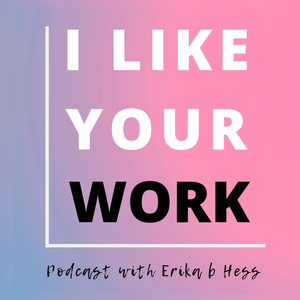
I Like Your Work: Conversations with Artists
Erika b Hess

2 Listeners
All episodes
Best episodes
Seasons
Top 10 I Like Your Work: Conversations with Artists Episodes
Goodpods has curated a list of the 10 best I Like Your Work: Conversations with Artists episodes, ranked by the number of listens and likes each episode have garnered from our listeners. If you are listening to I Like Your Work: Conversations with Artists for the first time, there's no better place to start than with one of these standout episodes. If you are a fan of the show, vote for your favorite I Like Your Work: Conversations with Artists episode by adding your comments to the episode page.
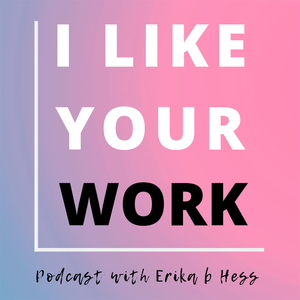
Room For Mistakes: Artist Matt Bollinger
I Like Your Work: Conversations with Artists
05/28/21 • 54 min
Matt Bollinger is an artist living in Ithaca, NY who works across painting, animation, sculpture and music. Bollinger earned his BFA at the Kansas City Art Institute in 2003 and his MFA at the Rhode Island School of Design in 2007. He has had 6 solo exhibitions at Zürcher Gallery, New York and 3 solo exhibitions at Galerie Zürcher, Paris. His animations have been included in numerous film festivals and screenings in the US and Europe. His work is in the collections of the Nerman Museum of Contemporary Art (Kansas City, MO), Museum of Fine Arts (Dole, France), and the Bowdoin College Museum of Art (Brunswick, ME) Recent solo exhibitions include Extended Present, at the South Bend Museum of Art (South Bend, IN) and Labor Day at M+B (Los Angeles, LA). In 2020, Zürcher Gallery participated in the Armory Show for the first time with a duo-presentation of Staver and Matt Bollinger in the Focus Section, curated by Jamillah James.
TAKEAWAYS FROM THIS EPISODE:
-Everything comes from drawing
-Base idea for work coming from a sentence
-Creating character sheets for different paintings
-Researching his work
-Vulnerability and empathy of the characters
The primary direction of light
-Think in tone
-Always looking
-Making the soundtrack for his animations
-How much sound impacts the work
-Drawing with sound
Never being shy about talking about his work
-Kerry James Marshall
Remove process hurdles
How COVID impacted his practice
Finding ways for freedom
LINKS:
https://www.mattbollinger.com/ https://www.instagram.com/mattlbollinger/?hl=enI Like Your Work Links:

2 Listeners
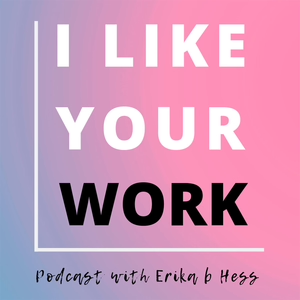
Getting Real About Being a Mother Artist with Brandi Hoffer
I Like Your Work: Conversations with Artists
05/07/21 • 61 min
Since becoming a mother in 2014 Hofer has been involving her children in her painting process, creating a 44-piece series with her first son and will soon be launching a new collection with her other 2 children in fall 2021. Brandi continues to be extremely prolific with her 3 little boys at her in-home studio, creating several bodies of self-motivated artwork, custom commissioned pieces, stunning large-scale interior/exterior murals, prints, custom artwork, & working with designers. Tiny hands play a role in all that she creates!
Hofer is a well collected Canadian Artist, exhibiting internationally and across North America. Her main focus is figurative, abstract and portraiture painting, she explores themes of empowerment, positivity, love, and inclusion.
Her work has been featured on national television and can be found in international publications. She has experience in creating custom artworks for designers and translates her artwork into large-scale murals. Hofer has attended residencies at Red Deer College, Toronto Island, the Marnay Art Centre outside of Paris France, and Montreal, Quebec. You can listen to her interviews about her life and process on several podcast platforms. Her work has appeared in HGTV’s House of Bryan, and featured in a General Motors commercial. Most recently herself and her family have partnered with a HUGE brand for an international commercial, but shhh we can't share just yet!! Stay tuned!
Brandi Hofer's studio where she works and creates is located in the Canadian prairies. Hofer studied in Red Deer, Alberta, at Red Deer College from 2004 - 2006 before transferring to the Nova Scotia College of Art & Design in Halifax, where she completed her Bachelor of Fine Arts in 2008.She has been ambitiously pursuing her career upon attaining her BFA degree.
You can find all of our studio adventures on Instagram! There you will find our podcast features, live interviews, and new collection releases.
TAKEAWAYS FROM THIS EPISODE:
-Choosing to move closer to family
-How personal loss can open your eyes
-Melting together family and art work
-Post Partum Depression and the NICU
-Spending time with kids in the studio
-E-book she released
-Pennyland Shen
-Burn out and recovery
-Mentoring People
-Having goals
-Getting Outside to Fight Burnout
-Self-care
-Deciding what you can and can’t do
Words of advice to moms who want to be an entrepreneur
-Finding role models
-Don’t get on a path that makes you miserable
-Work together
-Everyone starts somewhere
LINKS:
@brandihoferartist
https://www.brandihofer.ca
I Like Your Work Links:
1 Listener

Level Up: Insight for Mid-Career Artists with Ceri Hand
I Like Your Work: Conversations with Artists
03/14/25 • 56 min
Ceri Hand is a creative coach, mentor, host of the Extraordinary Creatives podcast, public speaker and the founder of www.cerihand.com, supporting thousands of creatives to make an impact with their work and earn more money doing what they love.
Prior to establishing Ceri Hand she was Director of Programmes for Somerset House, responsible for the exhibitions, live events, learning and skills programme across the whole historic site. She successfully helped to build its profile and brand, shaping its reputation as one of the UK’s top 10 most visited arts attractions (2.5million visitors annually).
Significant highlights include landmark exhibitions such as Mushrooms: The Art, Design and Future of Funghi; Get Up, Stand Up Now: Generations of Black Creative Pioneers; Good Grief, Charlie Brown! Celebrating Snoopy and the Enduring Power of Peanuts; Hassan Hajjaj: La Caravane, in partnership with 1-54 Contemporary African Art Fair; commissioning filmmaker Bradford Young for the annual Film4 Summer Screen programme; Anna Meredith and GAIKA for the ice-rink and Kojey Radical and Little Simz for the outdoor concerts Summer Series.
During her time there, she also successfully commissioned artists based within Somerset House Studios including Hannah Perry, Larry Achiampong and GAIKA, as well as commissioning new work for 1:54 AFrican Art Fair, Photo London, British Council International Fashion Showcase, and the London Design Biennale.
Throughout her career she’s worked with and commissioned new work from thousands of artists including notably: Hans Peter Feldmann, Gary Simmons, Angela Bulloch, Vito Acconci, Pipilotti Rist, Bedwyr Williams, Toby Ziegler, Dexter Dalwood, Chen Chieh-jen, Walid Raad/The Atlas Group, Sophie Jung, Anthea Hamilton, John Akomfrah and Black Audio Film Collective, Christian Jankowski, Apichatpong Weerasethakul, Sissel Tolaas, Shilpa Gupta, Salla Tykka, Candice Breitz, Yang Fudong, Jill Magid, Cory Arcangel, Jeremy Deller & Alan Kane, Naeem Mohaiemen, Ran Huang, Paulina Olowska, Claudio Parmiggiani, João Penalva, Mai-Thu Perret, Michelangelo Pistoletto, Josephine Pryde, Hugh Scott-Douglas, Jim Shaw, Clare Woods and Heimo Zobernig.
Ceri’s other previous roles include: Associate Director: Institutions and Public Relations, Simon Lee Gallery, London; Associate Consultant, Contemporary Art Society, London; Director, Ceri Hand Gallery, London/Liverpool; Director of Metal, Liverpool; Director of Exhibitions, FACT, Liverpool; Deputy Director of Grizedale Arts, Cumbria and Director of Make, London. Ceri is currently Chair of Castlefield Gallery, Manchester.
LINKS:
www.cerihand.com @cerihandI Like Your Work Links:
Apply to our Summer Exhibition & Publication at Chautauqua Visual Arts: https://www.ilikeyourworkpodcast.com/submitwork
Join the Works Membership! https://theworksmembership.com/
Watch our Youtube channel: https://www.youtube.com/@ilikeyourworkpodcast
Studio Visit Artist Interviews
Say “hi” on Instagram
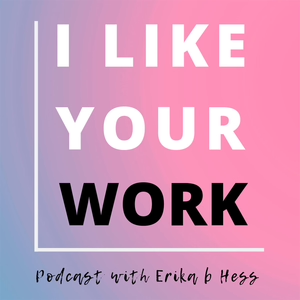
Claiming the Time In Between-Making Every Day a Studio Day with Artist Hilary Doyle
I Like Your Work: Conversations with Artists
02/19/21 • 44 min
The time in between is something we all deal with in life. The time between waking and coffee, the time between arriving in a doctor’s office and waiting to be seen, the time spent in transportation going from one point to the next. Hilary Doyle took that time and claimed it not only as studio time, but it became a jumping off point for her recent work.
Hilary Doyle is an artist, teacher, curator and gallery co-director. Doyle’s work includes painting, drawing, printmaking and sculpture about gender, class and psychology. She is newly represented by Taymour Grahne Gallery in london. Recent solo shows include “Metropolis” with Taymour Grahne online in august 2020, as well as “Echoing Voices” at One River School in November 2019. Her work has received press coverage in Hyperallergic, Bushwick Daily, and New American Paintings Blog.
Doyle is faculty at Rhode Island School of Design. She has taught for the last 8 years at various schools including Purchase College and a three year appointment with Brown University.
Doyle founded and co-directs NYC Crit Club with co-director Catherine Haggarty which was just included in observer magazines Arts Power 50: Change makers in the art world. She is also a gallery Co-Director and curator at Transmitter gallery in Brooklyn.
Doyle received an MFA from Rhode Island School of Design and a BFA from the Massachusetts College of Art and Design. She has an upcoming group show with Taymour Grahne Projects Contemporary Domesticity and Solo Show there in 2022. She also has an upcoming group show “The Symobolists: Les Fleurs du mal (the flowers of Evil)” at Hesse Flatow in Chelsea in February.
“Worcester, MA, where I grew up is one of many downtrodden, post-industrial cities across the US, filled with dilapidated factory buildings, joblessness, and overgrown yards. In cities everywhere people travel through similarly distressed spaces daily: the streets and subways full of zoned-out people caught up in the daily grind, staring with purple rings under their glassy eyes. This work examines contemporary working-class life. Focusing on the conditions in which people live helps us examine the rituals, psychology and emotions of daily life.
The work starts with mundane moments observed while commuting or while at home: a man staring at his phone while laying in bed or a woman balances on a yoga ball holding a baby. From these moments I make sketches, videos, iPhone drawings, or sculptural models to inform drawings and paintings. I experiment to discover relevant marks for each subject: a quick mark for the view out a window of a speeding bus, or a slick mark for tiles on the wall of a subway station.
Strangers, although unknown to us, are always leaving evidence about themselves as we catch a glimpse of them. People reveal their disposition in their folded arms, baby carts, laughing eyes, tightly clutched bags, or work uniforms. These clues spark imaginary narratives about peoples lives in each work. To examine fragments of people's lives, brings attention to the joys and struggles of ourselves and others.
Since the pandemic the work has become more imaginative and symbolic - using paintings within paintings to talk about the subjects within them. In our new surreal pandemic era fiction has become reality.”- HD
TAKEAWAYS FROM THIS EPISODE:
-Claiming “in between time” as your studio time
-Tips on Monotype Printmaking
-Printing at home
-Not wasting materials by planning ahead
-Using digital mediums
-Guerra
-Consider everyday a studio day
-Make art at any moment
-Working while breastfeeding
-Try not to go a single day without being creative, even if it’s just thinking
-Becoming more inventive
-Becoming more fearless after becoming a mother
-NYC Crit Club
-Transmitter Gallery
-”Stack your life”
-Having a routine
Artist Shout Outs:
Thank you to friends who do text critiques with me over the years
Catherine Haggarty, Claudia Bitran, Francisco Moreno and Meredith Iszlai.
LINKS:
Represented by Taymour Grahne Projects in London
Recent solo shows include “Metropolis” with Taymour Grahne online in august 2020, as well as “Echoing Voices” at One River School in November 2019.
She has an upcoming group show with Taymour Grahne Projects Contemporary Domesticity and Solo Show there in 2022. She also has an upcoming group show “The Symobolists: Les Fleurs du mal (the flowers of Evil)” at Hesse Flatow in Chelsea in February.

Weaving Stories of Female Strength & Creating a Fiber Non-Profit with Jessica Pinsky
I Like Your Work: Conversations with Artists
04/30/21 • 55 min
I have followed Jessica Pinsky’s work since 2007 because this woman was my best friend in graduate school at Boston University. We would visit each others studios, talk about art over drinks and overall support and give feedback to each other. Jessica’s drive to create artwork and start major projects is unmatched which is evident in her prolific work and the space she has created in Cleveland, OH Praxis Fiber Workshop that houses looms, a gallery space, a shop, a dye garden and now a digital weaving lab.
In this episode, Jessica and I talk about her current body of work that responds to her pregnancy journey, taking risks in your work, setting up parameters in your work, and starting a fiber workshop.
Jessica grew up in Akron, Ohio and moved to Cleveland in 2011 after receiving a BFA in Studio Art from New York University in 2006 and an MFA in painting from Boston University in 2009. She began teaching at Cleveland Institute of Art in 2011 and is currently serving as faculty in the Sculpture and Expanded Media department. Together with Cleveland Institute of Art, Jessica founded Praxis Fiber Workshop, a community textile studio in June, 2015 and continues to serve as the Executive Director.
“My work is planned and executed based on degrees of equality. Previous work has closely examined color and form within cloth, and is consistently pushing the boundaries of the structure of woven cloth. With lots of experimentation I discovered I could make cloth behave very differently with the same basic materials, but changing just a few things about those materials. For example, I can hand spin yarn to be very tight and twist upon itself, or very loose so it hangs without body. My weavings explore a metaphor about how human beings are made of the same material, but can behave very differently.”
TAKEAWAYS FROM THIS EPISODE:
-Taking a risk in your work
-Starting a new medium
“If you don’t feel a little bit afraid there is something wrong”
“We just have ourselves and our inner voice”
Always be learning
Her experience buying a building
Starting Praxis Fiber Workshop
Creating a natural dye garden
Digital Loom
Creating a residency program
Working in strict parameters
Making more personal work
Healing Imagery
Stolen hours in the studio
Knowing yourself
Artist Shout Outs:
Rowland Ricketts http://www.rickettsindigo.com/
Cathryn Amidei https://www.cathrynamidei.com/
Tina Cassara
LINKS:
https://www.jessicapinsky.com/
https://www.instagram.com/jpinsk/?hl=en
https://praxisfiberworkshop.com/
I Like Your Work Links:
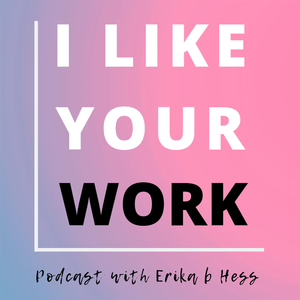
The Work Doesn’t Stop When You Leave: Artist Catherine Haggarty
I Like Your Work: Conversations with Artists
02/05/21 • 65 min
It was such a pleasure to have Catherine Haggarty on the show! Catherine is an artist based in Brooklyn, NY who recently had a solo exhibition at Massey Klein Gallery. She is also co-director of NYC Crit Club, a space offering community, connection and critiques for artists. In this interview, Catherine talks about learning how to make work when no one is looking and how this has served her as an artist moving forward in her practice. We also discuss her current work that she recently exhibited at Massey Klein Gallery in the Lower East Side.
Catherine Haggarty’s paintings are reminiscent of the brief moment we experience waking up from a dream. When everything rises to the surface at once. The edges of objects blur and we wonder what we just saw. You can try to hold onto the experience, but you can’t completely keep the image in your mind, rather the image dissolves into something else. This is how I read Catherine’s paintings, as a back and forth between reading forms and reading space. The painting continually reconfigures itself as your eye is drawn to references of animal figures that you read as a positive shape. This figure then flips to become a negative space, bringing your eye deeper into the painting.
Haggarty’s paintings and curatorial work have been reviewed by and featured in Bomb Magazine, Artnet, Hyperallergic, Two Coats of Paint, Brooklyn Magazine, The New York Times, Maake Magazine, Art Maaze Magazine, Art Spiel, Final Friday Podcast, Sound and Vision Podcast, The Black and White Project, Curating Contemporary’s book Eraser, and Young Space. Catherine has been a visiting artist & critic at SUNY Purchase MFA (2020), Hunter MFA (2020), Denison University (2020), Brooklyn College MFA (2019) and in 2018 Haggarty was the Anderson Endowed Lecturer at Penn State University. Haggarty’s solo, An Echo’s Glyph at Massey Klein Gallery in the Lower East Side is on view Dec 18th 2020 - January 30th, 2021. Previous solo shows include This Friday Next Friday (NYC), Bloomsburg University (PA), One Main Window (NY), One River School of Art and Design, Proto Gallery (NJ), and Look and Listen in Marseille France.
Haggarty earned her M.F.A from Mason Gross, Rutgers University in 2011. Currently, Haggarty is an adjunct professor at The School of Visual Arts (SVA) also co-directs NYC Crit Club with artist and critic, Hilary Doyle.
“In the summer of 2019 I visited ancient caves in France. I remember the temperature of the caves, the lines of raw earth pigment that formed figures & animals on the dark, damp walls. The connection to drawing and to pigment begins with our ancestors and threads through time to present day. I explore the differences between painting and drawing because the shared language offers insight on how we perceive and understand images.
By combining color, form, and patterns, I am able to expand the associations sparked by abstract animal signifiers. The level of representation in the work oscillates between recognizable figurative outlines to fields of color suggesting shape. To me, painting is both additive and subtractive and has no exact set of steps of production - rather a framework that allows in specific gestures, colors and marks in an irreversible order. This unplanned exchange requires my attention to where the patterns and marks lead me. I aim to remain open to movement and unforeseen connections in the work, a practice that reflects my studio habits and my way of operating in the world.
I avoid the notion of ‘knowing’ a form in visual language by conflating soft edge form that pushes against high saturations. Confounding spatial logic and touch in this way offers more questions than answers. The collection and also the subversion of various animals' coats, footprints and patterns in the paintings is far more interesting to me than the naming of the animal. I am not interested in the depiction of the one thing, rather I am interested in how my processes and materials can work with me to create new associations of the subject at hand.
The slippage of form in my paintings mirrors a slippage in language and meaning I notice in the world. Words are entirely abstract - they signify the subject at hand but often morph meaning with context, time, and language. Visually, I am interested in my process and subjects can mirror this dance. This fictional space I build is not based in a logical perspective or specific environment. Pattern is used as a tool to build an environment through repetition and motion - this defies the idea that animal forms might live in a specific space.”-CH
TAKEAWAYS FROM THIS EPISODE:
-Learning how to make work that nobody likes or will see
-Not knowing how you are going to get where you want to be, but taking the steps anyway
-Building the community you want to be a part of
-Supporting and being in contact with more artist...
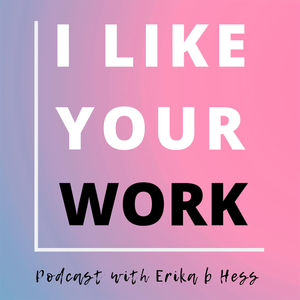
Artistic Success Through Balancing Art Making and Organization: Adrienne Elise Tarver-NYT Emerging Artist To Watch
I Like Your Work: Conversations with Artists
12/25/20 • 48 min
Adrienne Elise Tarver is an artist who makes hard work look easy. From her expansive studio practice, to her position as the Associate Chair of Fine Arts at Savannah College of Art and Design’s Atlanta Campus, Adrienne is able to gracefully accomplish making insightful, challenging work while also organizing a great spreadsheet. In this episode, we talk about how she balances art making and organization to achieve success.
With a practice that spans painting, sculpture, installation, photography, and video, Tarver’s work addresses the complexity and invisibility of black female identity in the Western landscape, from the history within domestic spaces to the fantasy of the tropical seductress.
“I often use the tropics as a starting point to look at the complexity of origin stories and histories of displacement. Using this familiar imagery, I confront artists like Paul Gauguin and Henri Rousseau and their imaginations of the tropics, considering the problematic perspective from which they were creating, and challenging the ideas they have perpetuated.
Recent work seeks to go beyond the origin story and investigate the future. Pulling from nearly forgotten histories and exploiting the inability to create a true or accurate representation of an ancestral home, I collect imagery and ideas that resonate internally.
Throughout my practice, I wonder: if mythologies from an imperialistic past can so thoroughly permeate our present identities, can we re-configure the narrative to create new realities? If our current struggles are indeed a sign of progress, can we look forward and claim our space for a better reality in the future?” -Adrienne Tarver
She has exhibited nationally and abroad, including museum shows at the Bronx Museum of the Arts and Children’s Museum of Manhattan, as well as solo exhibitions at Ochi Projects in Los Angeles; Wave Hill in the Bronx, NY; Victori+Mo in New York; BRIC Project Room in Brooklyn; and A-M Gallery in Sydney, Australia. She has been commissioned for an upcoming New York MTA project, received the inaugural artist commission prize for Art Aspen in 2019 and was selected by ArtNet as one of “14 Emerging Female Artists to watch in 2017.” She has been featured in online and print publications including the New York Times, Brooklyn Magazine, ArtNet, Blouin Art Info, Whitewall Magazine, Hyperallergic, Ingenue Magazine, among others.
She is currently the Associate Chair of Fine Arts at Savannah College of Art and Design’s Atlanta Campus (SCAD Atlanta). She received her MFA from the School of the Art Institute of Chicago and BFA from Boston University.
Sponsors:
SAVE $25 on Money BootCamp- Sunlight Tax w code ILIKEYOURWORK25
NYC Crit Club is now accepting applications for Spring 2021 semester. Now in its fourth year, NYC Crit Club is offering 9 new courses this Spring via zoom with 8 new faculty and 30 guest speakers and critics from around the country.
TAKEAWAYS:
-Experimenting with every aspect of the art world
-Job tips for artists-Framing jobs to get started with when you move someplace new
-How admin experience can help you in your career
-Relocating with the arts and while being an artist
Her Nonprofit work teaching at Harlem School for the Arts-NYC
Working across media
How to loosen up in the studio with watercolors
-Being ok with uncertainty
Ignore the trends and go with what interests you.
LINKS:
http://www.adriennetarver.com/
http://instagram.com/adrienne__elise
https://www.nytimes.com/2020/02/20/arts/design/art-galleries-new-york.html
ArtNet Article -14 Women to Watch
I Like Your Work Links:
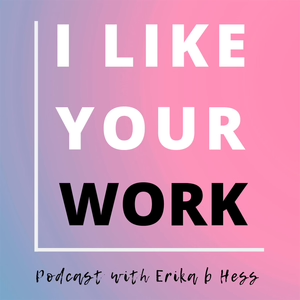
Give Yourself Permission: Anissa Lewis on Social Practice, The Power of Words, & Being Right On Time
I Like Your Work: Conversations with Artists
03/05/21 • 55 min
The work of Anissa Lewis dives into memory, yet is entrenched in her current community. Her photographs depict the present-day area in Covington, Kentucky, where Lewis grew up, and addresses the societal changes such as race, identity and relationships that have impacted the area over time. Images of the former residents are superimposed over images of the houses, to tell the stories of the people who made up the neighborhood decades ago. Lewis’s community-based signs address the here-and-now of citizenry, giving individual voices space to speak positively together. Lewis’s artistic work is intertwined with the community, and is constantly engaging with and responding to how the community shifts and changes over time.
In this episode, she describes her shift from a more traditional art background to finding and embracing social practice art. Anissa R. Lewis, community and teaching artist, was born and raised in Covington, KY by way of Philadelphia, PA—where she relocated after receiving her MFA from Yale School of Art. Lewis’ deep belief in community, identity and voice led her to many projects and collaborations including: an arts-based women empowerment classes for a Philadelphia County prison drug and alcohol abuse unit; a rites of passage program for black and brown teenage girls; student driven mural projects aimed to address civic engagement, neighborhood relationships and identity, and others.
Lewis’ work focuses on the power of place in her hometown neighborhood for which she has received a Creative Community Grant from the Center for Great Neighborhoods. Her photo-based prints, love letter yard signs and maps seek to reconcile her memories of childhood with the present-day neighborhood's changing social fabric, identity and the architecture of homes still present and those lost.
“While walking down a street in my hometown, many of my childhood friends’ homes are either boarded up or gone and now exist as open lots. The change of the neighborhood does not stop at physical structures, but includes race, age, socioeconomics, a community’s identity/culture, its aspirations and relationships. At the end of my walk down the street and memory lane, I realized that the neighborhood where I grew up no longer exists. New stories lay atop mine. This is nothing new in and of itself. I accept my insider/outsider perspective created by my relationship to a place that lives in a time past rather than what is physically present now.
In my photo-based prints, I seek to reconcile past and current my thoughts and experiences regarding these separate yet overlapping places about my childhood neighborhood. I do this by taking childhood photos and transposing them atop current houses in the neighborhood. As such, I am attempting to have a conversation about: What are the new stories alive and here now? Who is telling these new stories? In what ways do they differ from mine? What, if anything, remains from years ago that resonates with what now exists? Or, are stories and experiences parallel to the point where one longtime resident said, “I feel like a stranger in my own neighborhood." -AL
TAKEAWAYS FROM THIS EPISODE:
-Discovering things you thought weren’t for you but now are for you.
-Where you are born and where you find community
-Being Different-all valid and important to celebrate
FInding support and the importance in that
-When a one year sabbatical turns into a more substantial stay.
-Working for a non-profit about conflict resolution
-Discovering an interest in mixed-media
-The early 2000s was not as community based in terms of art practice
-Wanting to give back
-Navigating becoming a social practice artist
-”Do not need to split myself and do this art or that art.”
-Being civically engaged
-Believing in the power or words
-Neo Soul
-You are always right on time
-Dare to be clear and dare to be deliberate in your work
-Inappropriate comparisons
Thank you to our sponsor Sunlight Tax! Tax and money specifically for artists! https://www.sunlighttax.com/
Artist Shoutouts:
Blade of Grass https://abladeofgrass.org/
House full of Women
Amy Sherald http://www.amysherald.com/
Mary Clare Rietz http://maryclarerietz.com/
LINKS:
I Like Your Work Links:
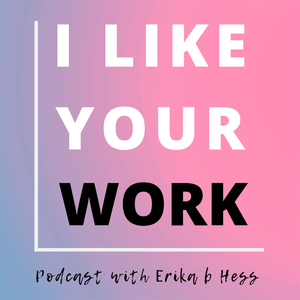
An Artist's Journey from Money Shame to Accounting Magic
I Like Your Work: Conversations with Artists
09/10/21 • 16 min

Writing About Color with Painter Eric Hibit
I Like Your Work: Conversations with Artists
09/16/22 • 40 min
Past guest and visual artist, Eric Hibit, joins me again today to chat about his work and his new book that he authored, Color Theory for Dummies which is a beginners guide to color theory for artists.
Eric Hibit was born in Rochester, New York and is a visual artist based in New York City. He attended the Corcoran College of Art + Design (BFA,1998) and Yale University School of Art (MFA, 2003). In New York, he has exhibited at Morgan Lehman Gallery, Dinner Gallery, Deanna Evans Projects, My Pet Ram, One River School of Art + Design, Tiger Strikes Asteroid, Underdonk Gallery, Ortega y Gasset Projects, Zurcher Studio, C24 Gallery, Anna Kustera Gallery, Max Protetch Gallery, and elsewhere. He has exhibited nationally at Weatherspoon Art Museum in Greensboro, NC, Adds Donna in Chicago, Curator’s Office in Washington, DC, Geoffrey Young Gallery in Great Barrington, MA, The Cape Cod Museum of Art, Satellite Contemporary in Las Vegas, NV, The University of Vermont, Bedford Gallery in Walnut Creek, CA and internationally in Sweden, France and Norway.
His work has been covered by the Washington Post, The Village Voice, Hyperallergic, Newsweek, New York Times and New York Post. Hibit has taught studio art at Drexel University, The Cooper Union, Suffolk County Community College, 92NY, Tyler School of Art, NYU and Hunter College. Artist residencies include Terra Foundation in Giverny, France (2003), UNILEVER Residency in New York (2015), and Kingsbrae International Residency for the Arts (2019) and Green Olives Arts in Tetouan, Morocco (2019). Publications include Dear Hollywood Writers, with poet Geoffrey Young (Suzy Solidor Editions, 2017) and Paintings and Fables with Wayne Koestenbaum, a limited edition artist’s book (2017), and Color Theory for Dummies, published by Wiley (2022). He is currently Co-Director of Ortega y Gasset Projects, an artist-run gallery based in Brooklyn, where he has curated exhibitions since 2014.
LINKS:
https://www.instagram.com/erichibit/
https://www.amazon.com/Color-Theory-Dummies-Eric-Hibit/dp/1119892279
Sponsors:
https://www.artworkarchive.com/ilikeyourwork
https://www.sunlighttax.com/ilyw
I Like Your Work Links:
Studio Visit Artist Interviews
Say “hi” on Instagram
Show more best episodes

Show more best episodes
FAQ
How many episodes does I Like Your Work: Conversations with Artists have?
I Like Your Work: Conversations with Artists currently has 239 episodes available.
What topics does I Like Your Work: Conversations with Artists cover?
The podcast is about Painting, Artist, Art, Visual Arts, Design, Podcasts and Arts.
What is the most popular episode on I Like Your Work: Conversations with Artists?
The episode title 'Room For Mistakes: Artist Matt Bollinger' is the most popular.
What is the average episode length on I Like Your Work: Conversations with Artists?
The average episode length on I Like Your Work: Conversations with Artists is 41 minutes.
How often are episodes of I Like Your Work: Conversations with Artists released?
Episodes of I Like Your Work: Conversations with Artists are typically released every 7 days.
When was the first episode of I Like Your Work: Conversations with Artists?
The first episode of I Like Your Work: Conversations with Artists was released on Sep 13, 2018.
Show more FAQ

Show more FAQ